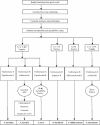Evaluation of partial 16S ribosomal DNA sequencing for identification of nocardia species by using the MicroSeq 500 system with an expanded database
- PMID: 14766819
- PMCID: PMC344514
- DOI: 10.1128/JCM.42.2.578-584.2004
Evaluation of partial 16S ribosomal DNA sequencing for identification of nocardia species by using the MicroSeq 500 system with an expanded database
Abstract
Identification of clinically significant nocardiae to the species level is important in patient diagnosis and treatment. A study was performed to evaluate Nocardia species identification obtained by partial 16S ribosomal DNA (rDNA) sequencing by the MicroSeq 500 system with an expanded database. The expanded portion of the database was developed from partial 5' 16S rDNA sequences derived from 28 reference strains (from the American Type Culture Collection and the Japanese Collection of Microorganisms). The expanded MicroSeq 500 system was compared to (i). conventional identification obtained from a combination of growth characteristics with biochemical and drug susceptibility tests; (ii). molecular techniques involving restriction enzyme analysis (REA) of portions of the 16S rRNA and 65-kDa heat shock protein genes; and (iii). when necessary, sequencing of a 999-bp fragment of the 16S rRNA gene. An unknown isolate was identified as a particular species if the sequence obtained by partial 16S rDNA sequencing by the expanded MicroSeq 500 system was 99.0% similar to that of the reference strain. Ninety-four nocardiae representing 10 separate species were isolated from patient specimens and examined by using the three different methods. Sequencing of partial 16S rDNA by the expanded MicroSeq 500 system resulted in only 72% agreement with conventional methods for species identification and 90% agreement with the alternative molecular methods. Molecular methods for identification of Nocardia species provide more accurate and rapid results than the conventional methods using biochemical and susceptibility testing. With an expanded database, the MicroSeq 500 system for partial 16S rDNA was able to correctly identify the human pathogens N. brasiliensis, N. cyriacigeorgica, N. farcinica, N. nova, N. otitidiscaviarum, and N. veterana.
Figures


References
-
- Brown, B. A., and R. J. Wallace, Jr. 1994. Broth microdilution MIC test for Nocardia spp., p. 5.12.1-5.12.9. In H. D. Isenberg (ed.), Clinical microbiology procedures handbook, vol. 1. American Society for Microbiology, Washington, D.C.
-
- Brown, J. M., and M. M. McNeil. 2003. Nocardia, Rhodococcus, Gordonia, Actinomadura, Streptomyces, and other aerobic actinomycetes, p. 502-531. In P. R. Murray, E. J. Baron, J. H. Jorgensen, M. A. Pfaller, and R. H. Yolken (ed.), Manual of clinical microbiology 8th ed., vol. 1. ASM Press, Washington, D. C.
Publication types
MeSH terms
Substances
LinkOut - more resources
Full Text Sources

